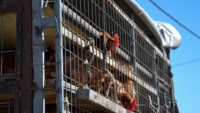Study Examines What STEC Dormancy During Lettuce Cooling, Transport Could Mean for Food Safety

Credit: Mark Stebnicki (nc-farm-bureau-mark) via Pexels
A Michigan State University researcher is working to characterize the physiological changes that occur in Shiga toxin-producing Escherichia coli O157:H7 (STEC) bacteria that is present on romaine lettuce during postharvest cooling and refrigerated transport to processors, which could affect the pathogen’s virulence and detectability characteristics. The end goal of the research, which is being funded by the Center for Produce Safety, is to develop an easily accessible online tool for industry that identifies practices to mitigate the risks of STEC transmission via romaine lettuce.
While several researchers have examined STEC on romaine lettuce in the field and during postharvest washing at processors, little is known about potential changes in the microorganism’s physiology during postharvest cooling and refrigerated transport to processors. Compared to the growing season and processing, the time romaine spends in coolers and refrigerated transport after harvest is relatively small. However, knowledge about what happens during the short period of time would be valuable information for industry.
The first two parts of the project, which involved systematically reviewing published literature on the subject and identifying data gaps, have been completed, and such information will be used to develop the basis of a risk model. Laboratory experiments that simulate the cooling and transportation of romaine are also underway. The researchers sought industry input to simulate conditions in the lab that reflect the real world, and used more than 5,000 harvest temperature data points shared by industry to inform their laboratory conditions.
In their laboratory experiments, the researchers are inoculating lettuce with strains of STEC, including strains from outbreaks that occurred in the U.S. in 2018, 2019, and 2020. After inoculating multiple lettuce plants with the pathogen, the researchers put the lettuce in a growth chamber for a day. The researchers then cut the romaine and placed it in a cooler to simulate harvest and cold storage. Each day over a five-day period, the researchers pulled samples and assayed the samples for STEC.
A noteworthy finding has been that of STEC’s dormancy. When under stress, some microbes, including STEC, transition to a dormant state known as “persister cells.” With a slowed metabolism, persisters do not reproduce but may still cause disease. When the stressor is removed, the cells’ metabolism returns to normal.
Another form of dormancy is “viable but nonculturable” (VBNC), which refers to cells that cannot be cultured on agar medium, preventing the use of common pathogen detection methods. As part of the project, the researchers plan to examine whether cold storage impacts STEC’s transition to persister and VBNC states.
It is unknown whether being in the persister state impacts pathogen detection. The researchers plan to purposely force cells into the persister state and determine whether they are detectable by common industry methods.
The study’s results will be used to fill gaps in the researchers’ developing risk assessment model, which will focus on practices to reduce STEC risk during the short window between romaine harvest and preprocessing. The researchers speculate whether there are modifications that could be made to harvesting and cooling practices that reduce the risk of STEC contamination, such as shifting harvest time or bringing lettuce to the cooling center more quickly.
Looking for a reprint of this article?
From high-res PDFs to custom plaques, order your copy today!






